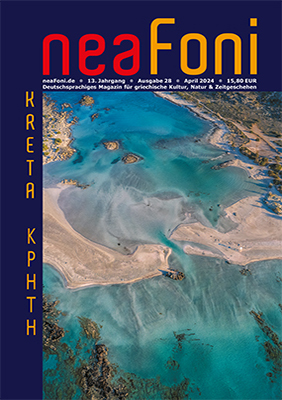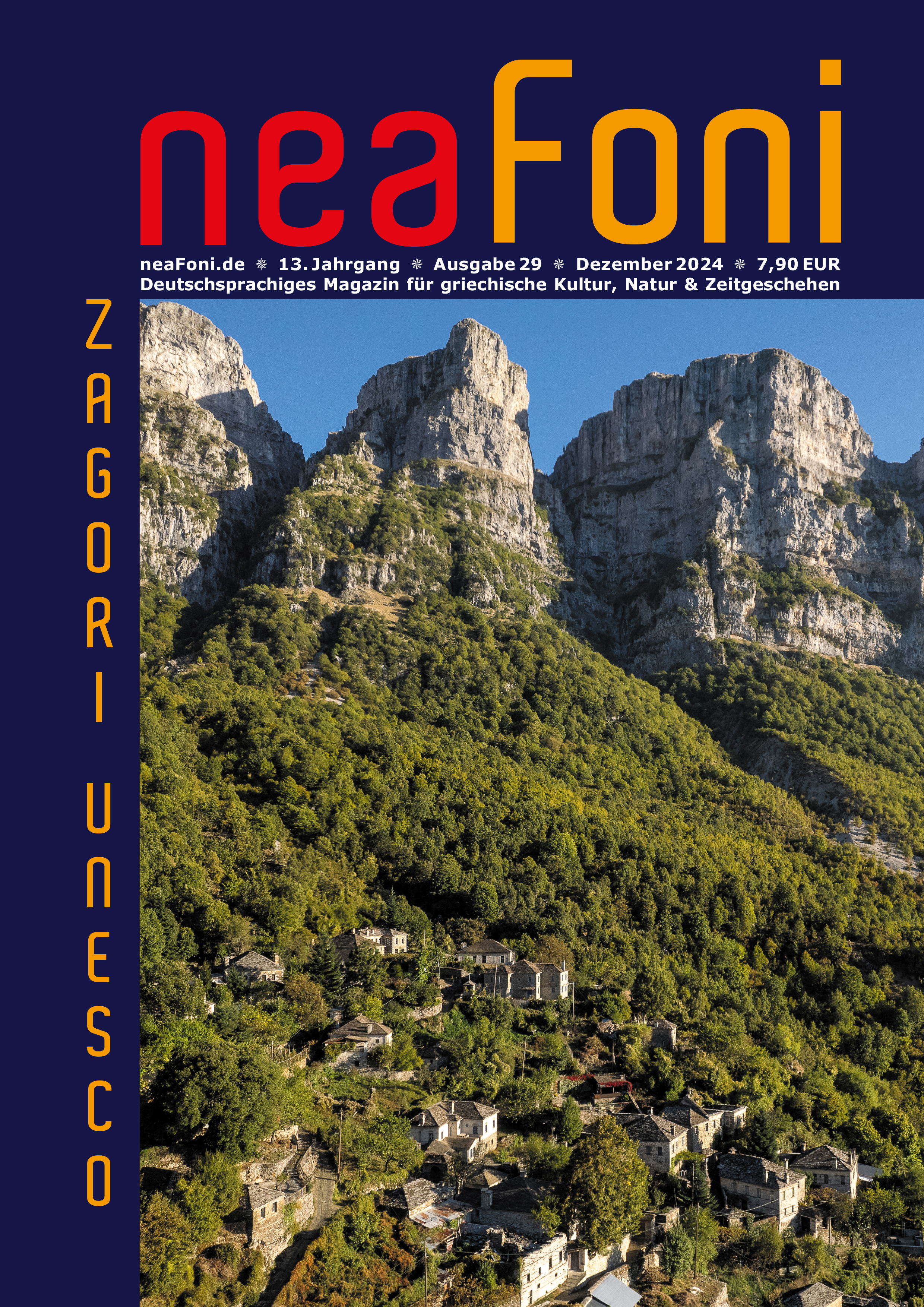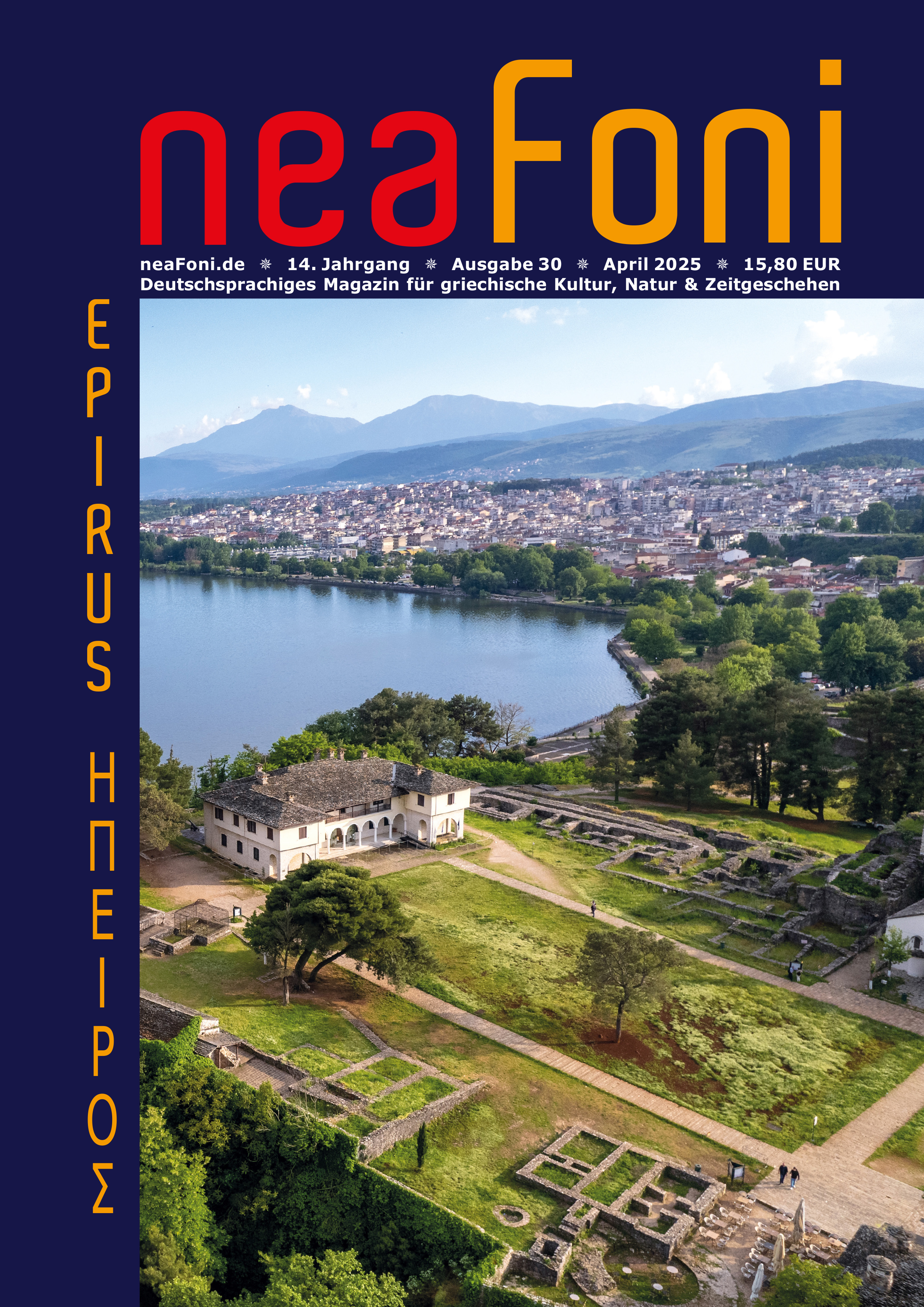Man mag diese nordägäische Insel mit allen möglichen Eigenschaftswörtern beschreiben, eines wird mit Sicherheit nicht darunter sein: lieblich. Sie ist wild, zerklüftet, wasserreich, windig, karg. Und: sie ist sehr imposant. Wer sie einmal besucht hat, kann nachvollziehen, daß einst hier die nach Eleusis zweitwichtigste Mysterienstätte Griechenlands beheimatet war, das Heiligtum der Großen Götter.
Schon bei der Anfahrt mit dem Fährschiff ist man beeindruckt, wenn die Umrisse des mächtigen, 1644m hohen und felsigen Fengariberges (Fengari bedeutet: Mond) allmählich wie aus dem Meer aufzutauchen scheinen. Doch die Gegenwart holt einen rasch wieder ein, wenn bei der Einfahrt in den Hafen von Kamariotissa die neuzeitliche Windkraftanlage mit ihren riesigen Windmühlen ins Blickfeld rückt, die in einer Linie nacheinander auf einer kleinen Landzunge stehen und die Energie der oft sehr heftigen Nordwinde einfangen.
Der Mythologie nach soll Poseidon vom höchsten Gipfel des samothrakischen Mondberges aus den trojanischen Krieg beobachtet haben.
Wild zerklüftet sind seine Täler, in denen Gebirgsbäche selbst im Hochsommer ins Tal brausen, teilweise mit imposanten Wasserfällen in deren ausgewaschenen Becken man sich mit einem kühlendes Bad erfrischen kann.
Man kann auch durch uralte Platanenwälder wandern und die Baumriesen bewundern von denen jeder seine eigene, individuelle Form hat.
Sandstrand wird man lange vergeblich suchen, es gibt nur einen, allerdings 700m langen und sehr schönen, Pachia Ammos, der aber ziemlich abgelegen ist. Wer sich aber auch mit Kies begnügen kann, wird sehr schöne Bademöglichkeiten finden.
Der Name Samothrake wird natürlich für immer verbunden sein mit der wunderbaren „Nike“, die hier am Heiligtum der Großen Götter gefunden wurde und heute im Louvre in Paris zu bewundern ist.
Auch in der Antike war die Insel sehr berühmt durch diese Mysterienstätte, die im gesamten Raum des östlichen Mittelmeeres bekannt war, hoch verehrt und viel besucht wurde. Hier lernte der Makedonenkönig Philipp II. (359-336 v.Chr.) seine spätere Gemahlin Olympias von Epirus kennen, die Alexander den Großen gebar.
Auch Herodot, Platon, Aristophanes und der römische Kaiser Hadrian sollen hier an den heiligen Zeremonien teilgenommen haben.
In der heutigen Zeit ist es ruhig geworden in Samothrake. Die etwa 3000 Einwohner leben hauptsächlich von der Landwirtschaft, der angebaute Weizen wird meistens exportiert. Daneben bilden der Anbau von Oliven, Fischfang und Tierhaltung (Ziegen und Schafe) die wichtigsten Existenzgrundlagen. Die Anbaumöglichkeiten sind allerdings begrenzt, da auf dieser mehr felsigen und kargen Insel nur im Südwesten fruchtbares Ackerland zu finden ist.
In den sechziger Jahren war das Leben auf Samothrake so schwer, daß viele ins Ausland, vor allem nach Deutschland, auswandern mußten um ihren Lebensunterhalt zu verdienen.
Touristisch ist Samothrake sehr wenig erschlossen. Es sind in erster Linie Griechen vom gegenüber liegenden Festland, die im Sommer hier ihre Ferien verbringen, viele davon, um eine Badekur in den Thermen von Loutra zu unternehmen. Das Fehlen von Sandstränden und die kurze Badesaison machen die Insel ziemlich unattraktiv für den Massentourismus und so bestehen die wenigen ausländischen Besucher in erster Linie aus Bildungsreisenden und Individualurlaubern. Die Anreise erfolgt mit dem Fährschiff von Kavala oder Alexandropolis.
In den letzten Jahren sorgte ein Open-Air-Festival im August für einige sehr turbulente Tage, wenn ein buntes Völkchen von Jugendlichen die Insel zu Zehntausenden förmlich überschwemmte. Nach Problemen mit Drogenkonsum wurde das Festival in diesem Jahr allerdings abgesagt.
Geographie
Samothrake liegt 40 km entfernt von Alexandropolis und 100 km entfernt von Kavala in der nördlichen Ägäis. Sie hat eine Gesamtfläche von 177 Quadratkilometern, eine Küstenlänge von 32 km und ist vulkanischen Ursprungs.
Die Umrisse von Samothrake erinnern an einen versteinerten Riesenkrebs, der mit 22 km Länge und 13 km Breite am Rand des 100 m tiefen Thrakischen Schelfs schwimmt. Das steil aufsteigende, dritthöchste Gebirge der Ägäis, das Oros Fengari, nimmt beinahe die ganze Insel ein. Nach Südosten fällt das Mondgebirge steil ab ins Meer, im Norden und Westen ist das Gefälle geringer. Dort umzieht ein breites Geröllband die Insel, gleicht die Küstenlinie aus und verleiht ihr einen glatten Umriß im Gegensatz zu den meisten anderen Ägäisinseln mit ihren charakteristischen Ingressionsbuchten. Daraus folgt das Fehlen von natürlichen Häfen. Es gibt auf Samothrake nur zwei künstliche Häfen bei Kamariotissa und bei Therma im Norden der Insel.
Strategisch liegt die Insel sehr günstig, dadurch konnten die Samothraker, vor allem nach der Kolonisierung der Gegenküste, den wichtigen Seeweg entlang der thrakischen Küste zum Hellespont und weiter ins Marmarameer und ins Schwarze Meer kontrollieren.
Geschichte
Einzelne Funde belegen die Besiedlung der Insel in der Steinzeit. In der Bronzezeit war sie bewohnt von indoeuropäischen Thrakern. Die griechische Kolonisation erfolgte etwa um 700 v. Chr., vermutlich von Lesvos oder Nordanatolien aus, da die Kolonisten den dort üblichen aiolischen Dialekt sprachen. Das Heiligtum der Großen Götter war zu dieser Zeit schon vorhanden und wurde von den Griechen in ihren Glauben übernommen. Die heilige thrakische Kultsprache wurde aber bis ins 1. Jahrhundert v. Chr. beibehalten. Die oben beschriebene, strategisch günstige Lage, war in der Antike neben diesem berühmten Heiligtum eine Ursache für den Wohlstand der Insel. Sie besaß eigene Werften für den Schiffsbau, die damals noch reichen Waldbestände lieferten das Baumaterial.
An den Perserkriegen im 5. Jahrhundert v. Chr. nahmen die Samothraker auf der Seite Persiens teil, nach der Niederlage der Perser traten sie dem Attisch-Delischen Seebund bei.
Nach der Eroberung Griechenlands durch den Makedonenkönig Philipp II. wurde die Insel ein Teil des makedonischen Reichs. Der letzte Makedonenkönig, Perseus, fand hier nach seiner Niederlage gegen die Römer im Jahre 168 v. Chr. Asyl im Heiligtum der Großen Götter, wurde jedoch von den Römern, die diese heiligen Bräuche nicht achteten, gefangengenommen. Dennoch behielt das Heiligtum auch in der Römerzeit seine Bedeutung und Pilgerscharen aus dem gesamten römischen Reich strömten nach Samothrake.
Den Niedergang leitete um 200 n. Chr. eine Katastrophe ein, wohl ein heftiges Erdbeben und im 4. Jh. n. Chr. wurde das Heiligtum endgültig geschlossen.
Anstelle der antiken Stadt gab es bis ins 15. Jh. n. Chr. nur ein kleines Dorf, der Hafen war schon seit dem 8. Jh. unbenutzt und versandete.
Die häufigen Piratenüberfälle veranlaßten im 9. Jh. die Bewohner wie auch auf vielen anderen Inseln, von der Küste weg ins sicherere Landesinnere zu ziehen und es wurde im Schutz einer byzantinischen Befestigungsanlage eine neue Stadt gegründet, Chora, die bis heute die Hauptstadt der Insel ist. Im späten Mittelalter (14. Jh.) vermachte der byzantinische Kaiser die Insel an die genuesische Adelsfamilie Gattelusi, die ihre Herrschaft durch Burgen und Wachttürme absicherte. Nach dem Fall des byzantinischen Reiches und dem Erscheinen der Türken ist von 1500 bis 1800 nichts bekannt über Samothrake. Erst durch die archäologische Forschung trat Samothrake in der Mitte des 19. Jahrhunderts wieder ans Licht.
Die Insel war noch lange nach dem Befreiungskrieg unter türkischer Herrschaft, erst im Jahr 1912 wurde sie griechisch.
Sehenswürdigkeiten
Das Heiligtum der Großen Götter
Es ist die größte archäologische Sehenswürdigkeit der Insel und liegt in Palaiopolis in hügeligem Gelände vor hoch aufragenden Bergen. Bei den Grabungen konnte es komplett freigelegt werden. Zu sehen sind die Reste des Anaktorons, das Hieron,ein Saal für Weihegaben, ein Propylon und ein durch seine Größe beeindruckender Rundbau, das Arsinoeon.
Museum
Das kleine Museum zeigt Funde aus dem Heiligtum: Skulpturen, Keramik, Schmuckstücke, Vasen aus Terrakotta, Votivgaben und Weihegeschenke.
Loutra (Thermi)
Wie der Name schon sagt, befinden sich hier Heilquellen. Es sind heiße Schwefelquellen, die von den griechischen Urlaubern vom Festland und auch von den Inselbewohnern gerne besucht und sehr geschätzt werden. Von Loutra aus kann man auch einen sehr schönen Spaziergang an einem Bach entlang durch den uralten Platanenwald unternehmen.
Fonias
Fonias (Mörder) heißt ein Fluß, der im Norden der Insel ins Meer fließt. Die Wanderung von seiner Mündung durch sein wildes Tal, eine der schönsten auf Samothrake, endet an einem beeindruckenden Wasserfall, wo er von steilen Felsen herabstürzt. Er hat an dieser Stelle ein natürliches Becken gebildet, in dem man sich nach der Wanderung abkühlen kann. Im Winter kann er sehr reißend sein und die Einheimischen erzählen, daß der „Mörder“ bis heute seine Opfer sucht und findet.
Chora
Vom Hafenort Kamariotissa sechs Kilometer entfernt, liegt die Hauptstadt der Insel (eigentlich ist es eher ein Dorf), wie eine Muschel geschützt am Hang einer Erosionsschlucht. Die Häuser scheinen ein Amphitheater zu bilden, die Gassen sind teilweise so eng und steil, daß mit Autos kein Durchkommen möglich ist. Die Byzantiner schützten Chora durch eine Festung, die im 14. Jh. von den Genuesen ausgebaut wurde. Es sind zwar nur noch Mauerreste und drei verfallene Wachtürme von der Gattelusi-Burg erhalten, durch ihre imposante Lage auf einem steilen, nur von Osten her zugänglichen Felsen ist sie noch immer eine Attraktion und ein Blickfang des Ortes.
Fengari
Der höchste Berg Samothrakes kann von Chora, Loutra oder Profitis Ilias im Süden der Insel in etwa 3-4 Stunden erstiegen werden. Wenn das Wetter klar ist, sind die Gipfel des Athos zu erkennen und die Inseln Thassos und Lemnos. Nach Osten reicht der Blick bis zur türkischen Küste und dem trojanischen Ida-Gebirge.
Wer mit offenen Augen Samothrake durchstreift, kann noch manche „Perle“ am Wegrand finden: ein altes Marienkirchlein auf einem steilen Berg über dem Sandstrand von Pachia Ammos, oder das kleine Kirchlein Agia Paraskevi direkt an der Nordküste, das an eine Marienerscheinung erinnert, die ein junger Fischer einst hier hatte. Mit einem herrlichen Blick auf die Südwestküste läßt sich der Genuß eines gebratenen Zickleins vom Spieß verbinden im Hangdorf Profitis Ilias, ein Ausflug, den vor allem die griechischen Urlauber gerne unternehmen und der ein stimmungsvoller Ausklang sein kann für einen entdeckungsreichen Tag auf Samothrake.
Der Kult der Großen Götter
Bis heute ist das Wesentliche dieses geheimnisvollen Mysterienkultes weitgehend unerforscht und obwohl sie in der ganzen griechischen Welt bekannt waren und großes Ansehen genossen, kennt man nur einige Einzelheiten durch Textstellen antiker Autoren, durch Vergleiche mit anderen bekannten Kulten und durch die Ausgrabungsfunde.
Im „Kult der Großen Götter“ wurden die Große Mutter Axieros, der Gott Kadmiros und das jugendliche Zwillingspaar der Kabiren verehrt, ursprünglich wohl thrakische Erd- und Fruchtbarkeitsgötter. Die Griechen übernahmen diese Gotheiten, fügten ihnen aber noch ihre eigenen Unterweltsgötter Hades und Persephone hinzu.
Die Mysterien von Samothrake ähnelten wohl denen von Eleusis insofern sich die Menschen von der Einweihung ein glücklicheres irdisches Leben und vor allem, ein zufriedenes Dasein nach dem Tode erhofften. Das Grauen, das die alten Griechen vor dem Tod empfanden hat Homer in seiner Odyssee sehr deutlich zum Ausdruck gebracht, als er die verstorbene Seele des Achilles zu Odysseus sagen läßt, daß er lieber ein Bettler in der Welt der Lebenden sei als ein König im Reich der Schatten.
Zur Einweihung waren interessanterweise alle Menschen zugelassen, nicht nur Griechen, sondern auch Angehörige anderer Volksstämme, Sklaven, Frauen und sogar Kinder.
Die Einführung in die Mysterien vollzog sich in zwei Stufen, die unmittelbar aufeinander folgen konnten, je nach Reifegrad des Einzuweihenden:
1. Die Einweihung (Myisis)
Sie fand öffentlich im Anakteron statt. Die Gläubigen erhielten ein großes Tuch, das sie vor Gefahren schützen sollte, und einen eisernen Ring, der als Amulett getragen wurde. Nach dieser Vorbereitung durfte der Myste das innere Heiligtum betreten, wo ihm von den Priestern heilige Symbole gezeigt wurden und rituelle Handlungen stattfanden.
2. Die Wahrnehmung (Epopteia)
Die Einweihung in den zweiten Grad war wieder mit einer rituellen Reinigung und der Schau heiliger Gegenstände verbunden. Sie wurde im Hieron durchgeführt und sollte den Mysten in seinem Entschluß bestärken, ein moralisch einwandfreies Leben zu führen.
Literatur
Leonie Senne: Inseln, Wein und Altertümer. Reisehandbuch Nord-, Mittelgriechenland
Reisebuchverlag Iwanowski ISBN 3-923975-15-5
Ingeborg Lehmann: Schroeder Reiseführer Griechische Inseln 4
Bruckmann KG München ISBN 3-7654-2381-6
Efi Kalamboukidou-Paschali: Samothrake, Geschichte, Archäologie-Reisen
Meandros Thessaloniki ISBN 960-7434-18-8
Evi Melas(Ed.): Die griechischen Inseln
DuMont Kunstreiseführer, DuMont Buchverlag Köln,
ISBN 3-7701-0877-9





